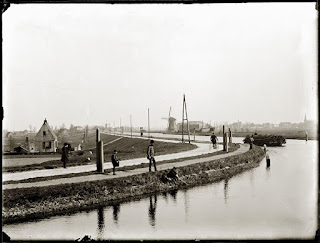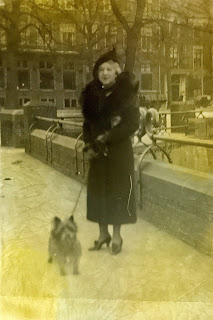About Johannes Blomberg, a father of ten.
Here in Australia Father's Day is the first Sunday in September but it wouldn't have mattered to my father. He thought that as long as he loved and looked after his family and was loved in return, that was enough for him. No need for a special day.
Father's Day is very much a twentieth century creation. Before that, in Roman Catholic Europe, St Joseph's Feast on 19th March was the day for celebrating fatherhood and paternal influence and values. However, my family, at least as far as I can trace back, were all protestant.
I have many large families in the tree and looking at these rows of children I do wonder, how did the fathers cope? How hard was it to feed that many mouths, keep them clothed, housed, educated?
One such large family was my great great grandfather Johannes Blomberg's family of ten. He was born 3 March 1828, Meppel, Drenthe, The Netherlands, to Jan Jansen Bloemberg, forty five years old, and his third wife Willemina Anna Krol, aged thirty six years. It is recorded on his birth record that his father was a "binnenvaart schipper", skipper of inland waterways.
 |
| Two types of ships for the Binnenvaart - Kat and Kof From Rijks Museum Amsterdam Print Collection, Public Domain Ref: http://hdl.handle.net/10934/RM0001.COLLECT.485369 |
Like father, like son, Johannes was also binnenvaart schipper and a merchant. On 8 September 1855, in Zwartsluis, aged twenty seven, he married Hendrika Lamberts Klein, who was just twenty years old, Their first child, my great grandfather Jan Blomberg, was born the following year on 12th June also in Zwartsluis. Ten more children were born in the family which settled in Zwartsluis, and only one lived to just one year old, the others all made it to adulthood and marriage and children.
Johannes had the care and responsibility of a growing family for a good twenty years and had to provide for a wife and small children until he was well into his sixties and seventies. And he clearly did not shirk his conjugal duties.
So how did a binnenvaart schipper provide for his family, what was that life like?
It wasn't easy. The work was unpredictable and did not provide a steady reliable income. A binnenvaart schipper transported goods between towns, villages, cities, on his sailing vessel navigating the inland rivers, canals and waterways. The depth was only one metre in these canals, and could drop if there was a dry spell, or be too high with the spring thaw or be impossible to navigate due to storms, or ice in winter.
From December to February the waterways were frozen, so no work, no income, but still ten children or sometimes more to feed. Binnenvaart schippers were known for their big families. Many had another job such as peat cutting or casual labouring to make up for the lack of income or like Johannes became merchants.
This was not a job you just applied for. The schipper had to buy the right to navigate his vessel in certain areas - like a licence or patent and usually it could be transferred to the son on request and a family could be in the binnenvaart for generations.
They owned their ships outright, no loans to finance the purchase. Often the father and family would invest in the purchase of the son's ship.
It was also dangerous work. The inland sea Zuiderzee was treacherous and unpredictable and many a ship with its crew was lost when the schipper took the risk to brave the storm to deliver the goods and earn his keep.
Running the ship and the transport business was very much a family affair. The father and his sons would see to the work that needed to be done around the ship, the sailing and navigating, while the wife and daughters did the housework, cooking, cleaning, washing and assisted with some of the lighter work around the ship. Everyone had their designated job, with the father clearly at the head of the firm.
 |
| Rokin, Amsterdam, a smaller binnenvaart ship. Photograph, James Higson 1904 Public Domain http://hdl.handle.net/10934/RM0001.COLLECT.438032 |
Throughout the nineteenth century the "binnenvaart" experienced many changes driven by economic, social and political forces which undermined the previously monopolistic position of the schipper supported by shippers guilds that also provided welfare to destitute schipper families.
The schippers' life was a unique life style. They were in port for at most 48 hours between jobs, so very difficult to go to school, make friends, be a part of a community. In this way they were very similar to that other mobile population - the gypsies.
By the time my great grandfather Jan was born in 1856, a railway network was growing, and steam powered vessels were becoming more common, although many schippers were suspicious of this innovation. They worried that the greater power and speed could damage the canals. But they couldn't keep up with the demand for faster shipping at lower rates.
Although he was the eldest and would have been the next one in line to take over the license, Jan Blomberg instead got a good education and went on to become a school teacher. It was told in the family that he was sent to special schippers schools because he was "a good learner".
So in my direct line Johannes Blomberg was the last of the binnenvaart schippers.
Note: For the information about the binnenvaart, I referred to
De Rijn- en
Binnenvaartschippers
1850-1945
Desirée Langius
d.langius@umail.leidenuniv.nl
1850-1945
Desirée Langius
d.langius@umail.leidenuniv.nl




Comments
Post a Comment